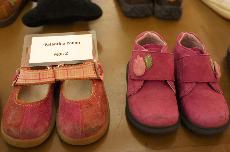Ninety-six pairs of high-top, black combat boots stand solemnly in the Carnegie Room in Hege Library; on each pair a small tag states a rank, a name and an age. A solitary pair sits atop a bookshelf; they belong to Sergeant Elmer Krause, 40, from Greensboro. Killed in action in May 2004, his smiling picture sits among medals and scrapbook memories. One memento is a letter from President Bush to his son: “Mrs. Bush and I send our heartfelt sympathy. We hope you will be comforted by your faith and the love and support of your family and friends. May God bless you.”
On Monday, April 7, “Eyes Wide Open: An Exhibition of the Human Cost of War” came to Hege Library. The exhibit runs through Friday and is sponsored by the American Friends Service Committee (AFSC). Since 1990, AFSC has worked in Iraq towards social justice, peace and humanitarian aid. The boots began touring the country in 2004 at AFSC headquarters in Chicago. It started with 504 pairs of boots donated by families of deceased soldiers; now there are over 1,400 pairs.
“Now that I’m seeing it, it’s very powerful, especially since my brother’s in the army,” said Laura Houpt, who helped set up the exhibit.
However, the exhibit at Guilford features the boots of North Carolinian soldiers, among them Sgt. Krause. Some of the boots look fresh with mud, some grayed by months in the sun, and others seem barely worn.
“It is a really important visual, it reminds people of the human cost of the war,” said Airlee Parham, president of GPeace, Guilford’s student activist club.
GPeace contacted local AFSC coordinator Debra Dillard to show the collection of local fallen soldiers. The display is not unfamiliar to the area; the main exhibit toured Greensboro in January 2005. More than 3,100 people came to see over 1,300 pairs of shoes displayed at the Depot, a restored train station.
“Eyes Wide Open” exhibits travel to colleges across the country showcasing soldiers’ boots from men and women in their home states.
“I’ve heard our generation referred (to) as the silent generation, so it’s important to have the exhibit come back,” Parham said. “The time for us to act is now.”
The companion piece, “Dreams and Nightmares: An Exhibition on Life and Death in Iraq,” is a photographic memorial to Iraqi civilians killed since the war and occupation. AFSC estimates between 420,000 and 790,000 casualties. While the actual photographs are touring the country, over 70 pairs of Iraqi shoes are displayed on the Carnegie Room’s shelves.
They are civilian shoes: sandals, high heels, flip-flops and loafers. They belong to men and women and range from the sneakers of Fadeela Zeeg Abdullah, 80, the trendy Adidas of Alea Abra Kata, 23, and even the flowery, pink sandals of two-year-old Valantina Yonan.
“I’ve heard the numbers, but seeing (the shoes) of a few dozen people and realizing that 100 times this many people died is just mind-blowing,” said Colin McMahon, a prospective student. “I’m glad to see stuff like this is happening here.”
With the death toll of US troops and Iraqi civilians rising every day, shoes will continuously be added in protest.
“When you see the scuff marks on children’s shoes, you know all the casualties are real people,” Houpt said.
Next to Bush’s condolence letter is a note scrawled by Sgt. Krause’s nine-year-old son, another victim of the war. It looks simple and crude next to Bush’s formal signature, but it sums up the essence of the “Eyes Wide Open” exhibition: “I miss you father.

